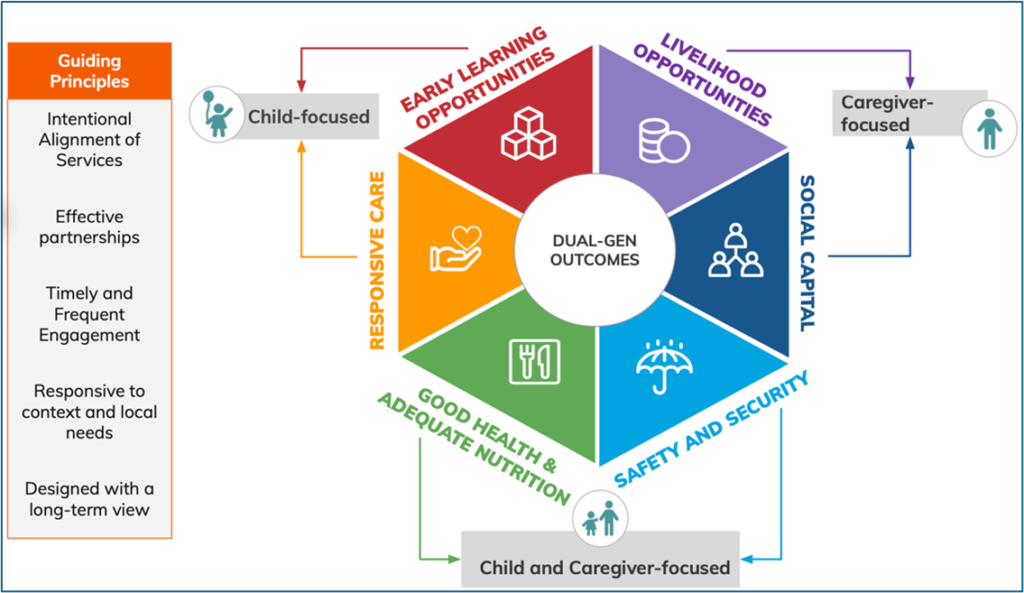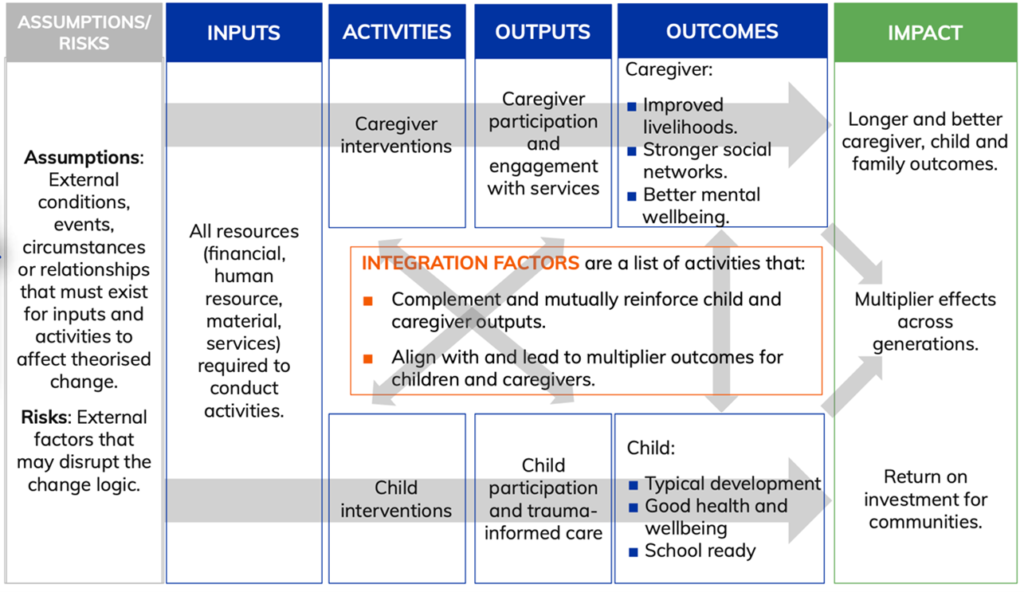Measuring outcomes for dual-generational programmes in fragile settings: insights from Ethiopia
Research indicates that only 25% of 3 to 4-year-olds in low- and middle-income countries receive sufficient nurturing care.
This highlights a widespread challenge families face in supporting their children’s development. This challenge is made worse in emergencies, which have become increasingly common. In 2019, over 71 million children under five were living in conflict-affected areas.
The family-first or dual-generational approach
In situations of severe adversity, young children (especially those six years and younger) need a positive and responsive relationship with a parent. Bronfenbrenner’s Ecological Models of Human Development emphasises the importance of adult support in a child’s life. A recent interpretation of this theory, the New Ecology of Early Childhood underscores a new set of circumstances affecting young children and their families, in unprecedented ways. Within this context, family-first or dual-generational approaches, which offer services to both children and caregivers to address the collective needs of the family, have been highlighted as critical, especially for children in fragile environments.

However, current interventions usually target one group over the other. One of the key reasons is the notable absence of programming frameworks, tools and resources to support practitioners to design and implement dual-generational approaches, especially on aspects of monitoring, evaluation and learning (MEL). Additionally, much of the existing discourse primarily focuses on the US context.
A toolkit for dual-generational programming
To address these evidence gaps, the Global Schools Forum (GSF) worked with Children in Crossfireand the Busara Center for Behavioral Economics to develop a user-friendly MEL toolkit for dual-generational programming, focused on emergencies. Children in Crossfire works in Ethiopia, where political instability, conflict and displacement pose ongoing challenges, and this provided an important real-world context for the toolkit’s development. The collaboration also benefited from Busara’s expertise in behavioural science. While GSF, with its network of 165 non-state actors, spearheaded the initiative.
Subscribe to our newsletter
Our weekly email newsletter, Network News, is an indispensable weekly digest of the latest updates on funding, jobs, resources, news and learning opportunities in the international development sector.
Subscribe now
The toolkit was developed through an in-depth literature review, a workshop with local partners, and a field-test in the Woliso woreda of the Oromia region in Ethiopia, an area which is impacted by economic and political instability, to assess the relevance and usability of the tools.
The following summarises our key learnings on how to measure the outcomes of dual-generational programmes in areas affected by emergencies, based on this collaborative effort.
Three key learnings from developing our dual-generational MEL toolkit
1. A dual-generational lens builds on the Nurturing Care Framework but expands focus to caregiver outcomes.
Existing research and practice tell us that children thrive when they receive nurturing care. This focuses on good health, adequate nutrition, safety and security, opportunities for learning, and responsive care. However, a dual-generational approach recognises that outcomes for caregivers are equally important in strengthening the impact on young children. While this is an emerging area, our current understanding emphasises caregiver-focused outcomes in three key domains: social capital, livelihood opportunities and psycho-social support.

For emergencies, the measurement framework needs further adaptation to account for the specific vulnerabilities faced by families in crisis. You can read more here.
2. Successful dual-generational programmes require meaningful integration of services for both children and caregivers.
For a dual-generational programme to succeed, activities must support both the child and the caregiver in ways that strengthen the entire family across generations. In some contexts, it may be necessary to include other caregivers and community health workers as part of the larger household context, particularly when children do not have immediate family support. Integrating these relationships into your theory of change and MEL systems is essential.
A theory of change template is below, and planning tools and templates can be found here:

3. Collaboration and contextualisation are critical in building effective dual-generational systems, especially in emergency situations.
Dual-generational programmes are inherently multi-sectoral as they require multiple expertise in areas like livelihoods, nutrition and education. To achieve such integration, collaboration across service providers is essential, as it’s often challenging for one organisation to deliver both child- and caregiver-focused interventions.
In fragile settings, co-creating with local actors is essential as conditions are dynamic and context specific. be carefully phased too, ensuring that the community remains actively engaged, trust is gradually built, and local systems are supported without being overwhelmed.
Advancing the field of dual-generational programming
Dual-generational programming addresses the intertwined needs of children and their caregivers. It shifts away from a segmented approach which targets individual groups, such as children, women or community health workers, to foster a more comprehensive understanding of change at the household level.
As the field of dual-generational programming continues to evolve, a longer-term view – in practice, policies and funding – will be required beyond immediate, short-term metrics and measurement processes.
We hope our toolkit will inspire stakeholders to adopt, test and refine this resource in diverse emergency contexts, generating more evidence and practical tools to advance the field. If you’d like to apply this in your context, or learn more about the toolkit, write to Priyanka Upreti at Global Schools Forum.
Category
News & Views
